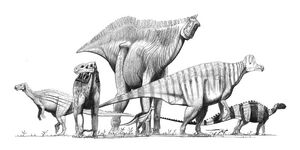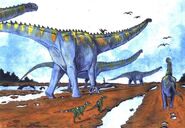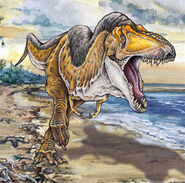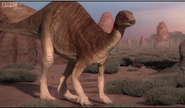m (→What is a dinosaur: link) |
(→What is a dinosaur: more info on dinosaur groups) |
||
| Line 53: | Line 53: | ||
*Saurischia ("lizard hips"): ''Megalosaurus'' and other dinosaurs more closely related to it than to ''Iguanodon''. They include: |
*Saurischia ("lizard hips"): ''Megalosaurus'' and other dinosaurs more closely related to it than to ''Iguanodon''. They include: |
||
**Theropoda (theropods: all two-legged, mostly carnivorous dinosaurs) |
**Theropoda (theropods: all two-legged, mostly carnivorous dinosaurs) |
||
| + | ***Ceratosauria |
||
| ⚫ | |||
| + | ****Coelophysoidea |
||
| ⚫ | |||
| + | ****Neoceratosauria (''[[Carnotaurus]]'' etc.) |
||
| − | ***Sauropoda (sauropods: long necked, small headed, four legged dinosaurs) |
||
| + | ***Megalosauroidea |
||
| + | ****Megalosauridae |
||
| + | ****Spinosauridae |
||
| + | ****Piatnitzkysauridae |
||
| + | ***Avetheropoda |
||
| + | ****Carnosauria |
||
| + | *****Carcharodontosauridae (''[[Giganotosaurus]]'' etc.) |
||
| + | *****Allosauridae |
||
| + | ****Coelurosauria |
||
| + | *****Tyrannosauroidea |
||
| + | *****Ornithomimosauria (ostrich dinosaurs) |
||
| + | *****Maniraptora |
||
| + | ******Oviraptorosauria |
||
| + | ******Therizinosauroidea (plant eating theropods with large claws) |
||
| + | ******Deinonychosauria ("raptors") |
||
| ⚫ | |||
| + | **Sauropodomorpha (sauropods and their relatives) |
||
| + | ****Plateosauridae |
||
| + | ****Massopoda |
||
| + | *****Riojasauridae |
||
| + | *****Massospondylidae |
||
| ⚫ | |||
(''NOTE: Birds are actually saurischian "lizard-hipped" dinosaurs and not ornithischians "bird-hipped" dinosaurs''.) |
(''NOTE: Birds are actually saurischian "lizard-hipped" dinosaurs and not ornithischians "bird-hipped" dinosaurs''.) |
||
Revision as of 21:58, 14 September 2013

Several ornithischian dinosaurs.
Dinosaur is a word that many people do recognize and know that there once were time in the past when a group of animals called dinosaurs did rule the Earth. The word has become very popular since it was first introduced by paleontologist Sir Richard Owen in 1842.
The popularity of dinosaurs may be due to that for many people dinosaurs seem to be fascinating because of their appearance and the huge sizes that some of them were able to grow. But even so many of these people do not actually know what a dinosaur really is, and what is not a dinosaur. The following text is here to tell about dinosaurs and what they are and what they are not.
The name "Dinosaur"
In the mid 19th century Sir Richard Owen named a taxon Dinosauria to describe a group newly recognized prehistoric animals those remains had been unearthed all over the world.
The name "dinosaur" comes from Greek worlds deinos ("terrible," "potent," or "fearfully great") and sauros("lizard" or "reptile"). Owen did not name them as dinosaurs for a reason that they would be very terrifying and dangerous monsters, instead he wanted to refer their sheer size and and majesty.
What is a dinosaur
Dinosaurs are a very diverse group of animals. Because they ruled the planed so long time they had had long time to adapt new environments and produce a huge array of different forms.

The 3 main types of hip joint in tetrapods (Dinosaurs and mammals in the middle) (most other reptiles at left.)
First of all, dinosaurs can be characterized as archosaurian reptiles with erect limbs. This means that dinosaurs held their limbs right beneath their body similar way as most modern mammals and unlike many reptiles that have limbs that sprawl out to either side (like lizards for example).
Dinosaurs can be defined as the most recent common ancestor of Iguanodon and Megalosaurus and all of its descendants. That is so because they were two of the three genera refered by Sir Richard Owen when he recognized this group of animals and named it "Dinosauria".
There is a list of certain features shared by dinosaurs and they can be used to determine what animals are dinosaurs and what are not. These characteristics are:
- A highly modified large manus (manus=distal portion of the forelimb/hand) with
- Semi-opposable thumb
- Grasping ability of digits (digit=finger/toe) II and III
- Reduced digits IV and V
- First dinosaurs were all two-legged but some later forms became four-legged again
- An enlarged muscle attachment surface (the deltapectoral crest) on the humerus (humerus=a bone in forelimb that runs from the shoulder to the elbow)
- A perforate acetabulum: the medial wall of the hip socket formed by the pubis and ischium in other amniotes(amniote=four legged animals other than amphibians and amphibian-like creatures) (including silesaurids (the closest relatives of dinosaurs)) is missing, and was simply cartilage. (In all but the most primitive dinosaurs, the wall formed by the ilium is also removed.) So, as preserved, there is just a hole between the ilium, pubis, and ischium in dinosaur pelves.

Dinosaur evolution
It is known today that birds are the descendants of theropod dinosaurs. In older taxonomy system they were considered as a separate group of animals that evolved from dinosaurs but the old classification system is not used anymore by modern paleontologists.
Modern taxonomy system requires that all descendants of a single common ancestor must be included in a natural group. In that sense because birds are descendants of theropods birds also are theropods and thus dinosaurs also. Thats why it is not quite right to say that dinosaurs are extinct because there is still living birds, but it is still right to say that non-bird dinosaurs are extinct or that most dinosaurs are extinct.
The term non-avian dinosaur is used to refer the non-bird dinosaurs (all dinosaurs that are not birds).
Dinosaurs are divided in two major groups:
- Ornithischia ("bird hips"): Iguanodon and other dinosaurs more closely related to it than to Megalosaurus. They include:
- Heterodontosauridae
- Thyreophora (mostly four legged armoured dinosaurs)
- Ankylosauria
- Stegosauria
- Neornithischia
- Ornithopoda
- Marginocephalia
- Pachycephalosauria (thick headed dinosaurs)
- Ceratopsia (horned dinosaurs)
- Saurischia ("lizard hips"): Megalosaurus and other dinosaurs more closely related to it than to Iguanodon. They include:
- Theropoda (theropods: all two-legged, mostly carnivorous dinosaurs)
- Ceratosauria
- Coelophysoidea
- Neoceratosauria (Carnotaurus etc.)
- Megalosauroidea
- Megalosauridae
- Spinosauridae
- Piatnitzkysauridae
- Avetheropoda
- Carnosauria
- Carcharodontosauridae (Giganotosaurus etc.)
- Allosauridae
- Coelurosauria
- Tyrannosauroidea
- Ornithomimosauria (ostrich dinosaurs)
- Maniraptora
- Oviraptorosauria
- Therizinosauroidea (plant eating theropods with large claws)
- Deinonychosauria ("raptors")
- Aves (birds)
- Carnosauria
- Ceratosauria
- Sauropodomorpha (sauropods and their relatives)
- Plateosauridae
- Massopoda
- Riojasauridae
- Massospondylidae
- Sauropoda (sauropods: long necked, small headed, four legged dinosaurs)
- Theropoda (theropods: all two-legged, mostly carnivorous dinosaurs)
(NOTE: Birds are actually saurischian "lizard-hipped" dinosaurs and not ornithischians "bird-hipped" dinosaurs.)
Some animals are confused with dinosaurs by general public who do not know what dinosaurs really are. Here is examples of some of them and this should help you to recognize that they are not dinosaurs.
- Closest relatives of dinosaurs include: pterosaurs, crocodilians, silesaurids, aetosaurs and ornithosuchids. These are archosaurs like the dinosaurs, but not dinosaurs themselves.
- Marine reptiles like plesiosaurs and mosasaurs are also not dinosaurs. They are not even archosaurs at all but several other kind of reptiles.
- Therapsids like gorgonopsids and dicynodonts are related to mammals and not dinosaurs. In fact mammals are a type of therapsids. They are also not dinosaurs.
- "Pelycosaurs", like Dimetrodon are related to therapsids so they are also not dinosaurs.
- Many other animals like turtles and lizards and insects are also not dinosaurs and there is not space for listing all. So best thing to do is just remember what dinosaurs have in common with each other and what groups are included in Dinosauria.






